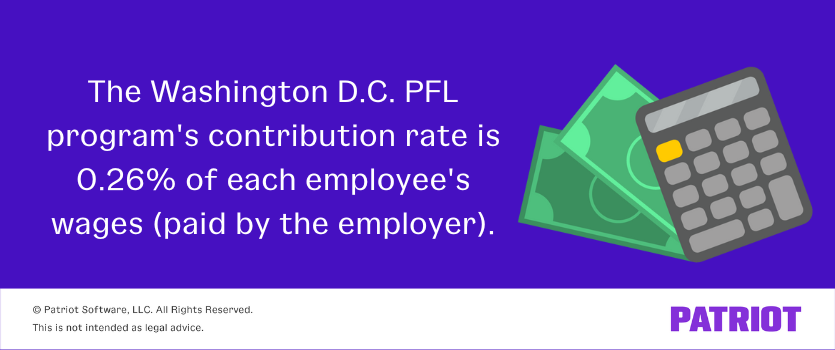States like New York, California, and Massachusetts have paid family leave programs so employees can take paid time off for medical and family issues. Along with a number of states, Washington D.C. also started a PFL program in 2019.
Read on to learn all there is to know about the Washington D.C. paid family leave program, including the contribution rate, employee eligibility, and more.
Washington D.C. paid family leave program
Washington D.C. paid family leave is a program fully-funded by employers. Because the program is employer-only, employers do not need to withhold premiums from employee wages.
Employers with at least one employee working in Washington D.C. are subject to the paid family leave program. The size of your business (e.g., 50 employees) has no effect on whether you must contribute to the D.C. PFL.
You must contribute to Washington D.C. PFL if you are covered by the D.C. Unemployment Compensation Act. Basically, all Washington D.C. employers required to pay unemployment insurance (UI) must participate. This also includes nonprofit organizations and household employers that pay unemployment insurance tax.
Self-employed individuals may choose to opt into the Washington D.C. family leave program.
Washington D.C. PFL gives qualified employees paid time off for certain family- or medical-related situations.
The program allows eligible employees to take paid time off to:
- Bond with a new child (up to 8 weeks)
- Care for a seriously ill family member (up to 6 weeks)
- Deal with a serious health condition or in the event of a stillbirth or miscarriage (up to 6 weeks)
- Take prenatal medical care leave, including routine and specialty appointments, exams, and treatments (up to 2 weeks before the birth of a child)
Within a 52-workweek period, an employee may receive two weeks of paid prenatal leave in addition to the maximum amount of parental leave. However, an employee cannot receive any combination of paid prenatal and medical leave that exceeds the maximum amount of medical leave (six weeks).
Employee eligibility
There are a few factors that determine whether an employee is eligible for Washington D.C. PFL. An employee must meet one of the following requirements to receive PFL:
- Works for a covered employer and spends more than 50% of time working in D.C. for that employer
- Is employed by a covered employer in D.C., spends a substantial amount of work time for that employer, and spends no more than 50% of time in another jurisdiction
- Is a self-employed individual who has opted into the Washington D.C. PFL program and performs at least 50% of their work in D.C.
Employees don’t need to work a certain amount of time to become eligible for Washington D.C. PFL. However, employers must report employee wages in order for employees to receive PFL benefits.
Contribution rate
Again, Washington D.C.’s paid family leave is solely funded by employers. This means employers do not withhold PFL from employee wages.
The Washington D.C. PFL program’s contribution rate is 0.26% of each employee’s wages. Employers must pay their contributions quarterly to Washington D.C. The quarterly contributions are based on the past quarter’s wages.

The quarterly due dates include:
- April 30 for Quarter 1
- July 31 for Quarter 2
- October 31 for Quarter 3
- January 31 for Quarter 4
An employee’s benefit amount is based on their wages. The current weekly benefit amount is $1,049.
Calculating D.C. PFL example
Say your employee earns $1,000 per paycheck before taxes and deductions. You pay your employee on a weekly basis. To calculate D.C. PFL, multiply your employee’s weekly gross pay by 0.26%.
Gross pay X 0.26% = Employer D.C. PFL contribution
$1,000 X 0.26% = $2.60
For this employee, you must contribute $2.60 per paycheck for D.C. PFL. Your annual contribution for this employee would be $135.20 ($2.60 X 52 weeks).
Remember, do not deduct D.C. PFL from the employee’s gross wages. You must contribute the premium as the employer.
Keep in mind your contributions might increase or decrease over time if your employees’ wages fluctuate (e.g., raises, demotions, etc.).
Washington D.C.’s website also offers a handy calculator to determine how much employers need to contribute per paycheck.
Reporting Washington D.C. PFL
Similar to unemployment insurance taxes, employers must also submit a quarterly wage report for paid family leave.
Use Form UC-30 to report employer PFL contributions to Washington D.C. each quarter. Employers record PFL contributions the same way they record and file quarterly reports for unemployment insurance. Applicable employers will receive Form UC-30 via mail.
You do not need to submit two UC-30 forms. You can use one form to cover both UI and PFL wages.
Payroll records and paid family leave
Employers must keep payroll records for at least three years.
Your records for D.C. PFL must include your employees’ names, SSNs, pay period dates, wages for each period, and dates of employment.
Washington D.C. PFL in a nutshell
If you feel overwhelmed by information, you’re not alone. Here’s a breakdown about the Washington D.C. paid family leave program:
- D.C. PFL is an employer-only contribution
- D.C. employers must contribute 0.26% of each applicable employee’s wages
- Qualified employees can take paid time off for certain family- or medical-related situations
- Duration of time off depends on reason for the leave
- Self-employed individuals can opt into the program
- The current weekly benefit amount is $1,049
- Employers must submit to Washington D.C. on a quarterly basis
Contact Washington D.C. for more information about the paid family leave program. Washington D.C. also offers an online employer toolkit to answer questions about the PFL program.
Looking for a way to simplify your payroll process? With an easy three-step process, Patriot’s payroll software makes running payroll a breeze. And, we offer free, USA-based support. What are you waiting for? Get started with a 30-day free trial today!
This article has been updated from its original publication date of June 12, 2019.
This is not intended as legal advice; for more information, please click here.


